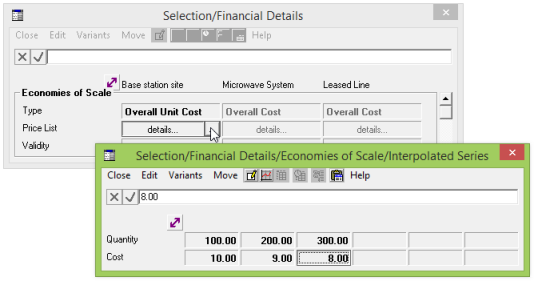By default, costs are specified as cumulative overall costs
per cumulative volume (1000, 1800, …). They may also be specified:
- as an overall cost (10, 9, …)
- as an overall discount factor (0.0, 0.1, …).
It is also possible to have stepped
changes in batch costs, or in discount rates – see below for more details.
All of these Price List inputs multiply the separate Capital Cost input, which must be defined at least as 1.0, or as a nominal cost when specifying discounts.
The cost (or level of discount) for specified numbers of a Resource are input as an Interpolated Series.

The total cost for intermediate quantities is calculated by linear interpolation, that is, linear from zero to the first breakpoint, and also beyond last breakpoint at same gradient as the last segment:

Linear interpolation of total costs is equivalent to a reciprocal interpolation between unit cost breakpoints. Therefore costs defined as unit costs or discount factors are first scaled by breakpoint quantities before interpolating as total costs; otherwise, linear interpolation of costs would give rise to an implausible piecewise quadratic interpolation of total costs!
Another familiar pricing model is to have step changes in batch costs, paying one rate or cost y1 up to the first n1
units, and then a lower rate y2 up to the next breakpoint n2. This implies a total cost of y1.n1 + y2.(n – n
1) in the interval [n
1,n2], which is thus equivalent to a linear interpolation on total cost between y
1.n
1
at n1 and y1.n1+y2.(n2 – n
1) at n2.
Select Type = Stepped Cost
to define the price list in this format. It is also possible to have stepped discount rates.
The default Price List is empty, meaning that it has no influence on the calculation of unit cost. STEM will otherwise check for Resources where this mapping has been defined but the unit cost has been left at zero. Quantities will be sorted and may not be repeated. Total costs must increase strictly monotonically.
For full generality, one would like to be able to specify a progression of price lists, each with an effective period (beginning-aligned). However, this detail would only really be justified if changes to the rate of volume discounting were likely to be of significant impact on a business plan. Most cases should be captured effectively by either an absolute price list and separate price trend, or with a time-series unit cost and relative price list.
Validity
By default, the number of units considered for pricing purposes is just the number of units installed in the current year. However, you can use the Validity input to define a longer period, over which incremental units are summed in order to determine the quantity for pricing purposes.
The incremental cost is the difference between the price read off from the Price List for this total quantity, less the price for the units already installed within the number of years defined by the validity of the Price List.